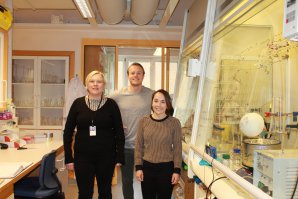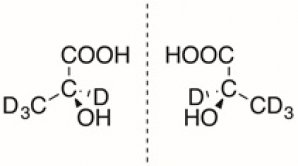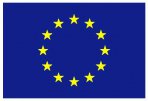Sweden: Deuteration of molecules using enzymes

Hanna, Anna and Oliver in their lab.
Typical routes for making per-deuterated molecules for neutron scattering use chemical methods that are unsuitable for molecules with sensitive functional groups, for example the use of metal catalysts, high temperature and high pressure. Therefore, Task 5.3 in SINE2020’s Chemical Deuteration work package explored the use of enzyme catalysts that are efficient, very molecule specific and generate few or no by-products during the deuteration process.
Specifically, SINE2020 colleagues at the ESS in Sweden and FZJ in Germany have been looking at the polymer polylactic acid. Neutron scattering is an ideal method to study the structure and properties of polylactic acid, but in order to make analysis easier and more useful, deuterated forms of the polymer are required.
Polylactic acid is made of building blocks (or monomers) of lactic acid joined together and they come in two forms that are mirror images (or enantiomers) of each other. The biodegradability of the polymer can be adapted by joining a mix of these enantiomers together making it important that deuterated versions of both lactic acid enantiomers are available.
Anna Leung and Hanna Wacklin-Knecht from ESS have made deuterated lactic acid monomers using enzymes. These have then been used by Andreas Raba and Jürgen Allgaier at FZJ and Klaus Beckerle at RWTH Aachen University to make deuterated polylactic acid. You can read about this in our article here.

Figure 1: Structures of L-lactic acid-d4 (left) and D-lactic acid-d4 (right)
Making lactic acid
First, a deuterated version of the precursor sodium pyruvate was made, which takes about 3 days. This is converted to lactate in an enzyme reaction over about 10 days, with the help of the enzyme Lactate dehydrogenase. It is then easy to change the lactate into lactic acid. The different L and D enantiomers (Figure 1) were made using a specific version of the Lactate dehydrogenase enzyme in each case.
Deuteration of lipids
The synthesis of lactic acid was not the only thing the team wanted to explore with enzymes. Another interesting molecule group to deuterate for neutron techniques are lipids, which ILL are producing biologically as discussed in our article here.
To build a deuterated lipid you make the head group and “legs” of the molecule separately and then join them together. This is often done chemically, but perhaps enzymes could prove useful for this process. Enzymes could remove the “legs” one at a time and reattach deuterated versions ready for neutron experiments.
Anna began exploring phospholipase enzymes for this task. However, it was not easy. Oliver Bogojevic joined the project in 2018, bringing knowledge of enzyme structure and function and experience working with enzyme manipulation. Still, enzymes are challenging things to work with and Anna and Oliver were constantly learning things by trial and error. Enzymes were easily denatured by high temperatures or changes in pH and they found that some enzymes have very narrow substrate specificity whilst others accept a broad range of substrates. The reactions needed constant monitoring and it was difficult to know how to analyse the products in terms of purity.
It was also complicated to increase the scale of production to make larger amounts, e.g. up to 100 mg of perdeuterated compound. This is because if you have more starting material, the interfacial areas where the important interactions occur do not scale in the same way i.e. doubling the starting material does not automatically double the surface area available. The team had to explore methods to mix the reactants in order to increase the interface areas appropriately. Work on this project continues; the ESS DEMAX team offered deuterated phospholipids in their first proposal call, issued earlier this year.
Despite the challenges, however, there are some great advantages of using enzymes. They are very selective, not chemically toxic, reusable and the number of steps required in a synthesis process are reduced.
The work carried out for SINE2020 has established an enzyme catalysis methodology, not just for these molecules, but one that should be compatible with a large number of other substrates and enzyme reactions. This will help to expand user access to a large range of high-value deuterated small molecules with neutron scattering applications.
Acknowledgements also go to the BrightnESS2 project which also helped fund this work.
Acknowledgements: Anna Leung, ESS
Back to The Road to the ESS
Other articles: Deuterated surfactants, Deuterated polymers, Deuteration of biomolecules, deuteration.net, Chemical Deuteration, DEUNET




